
Juno and or Juno Beach was one of five beaches of the Allied invasion of German-occupied France in the Normandy landings on 6 June 1944 during the Second World War. The beach spanned from Courseulles, a village just east of the British beach Gold, to Saint-Aubin-sur-Mer, and just west of the British beach Sword. Taking Juno was the responsibility of the First Canadian Army, with sea transport, mine sweeping, and a naval bombardment force provided by the Royal Canadian Navy and the British Royal Navy as well as elements from the Free French, Norwegian, and other Allied navies. The objectives of the 3rd Canadian Infantry Division on D-Day were to cut the Caen-Bayeux road, seize the Carpiquet airport west of Caen, and form a link between the two British beaches on either flank.
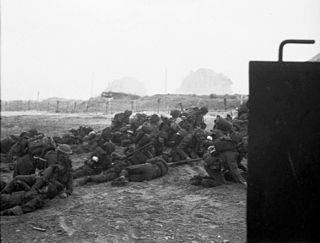
Sword, commonly known as Sword Beach, was the code name given to one of the five main landing areas along the Normandy coast during the initial assault phase, Operation Neptune, of Operation Overlord. The Allied invasion of German-occupied France commenced on 6 June 1944. Stretching 8 kilometres (5.0 mi) from Ouistreham to Saint-Aubin-sur-Mer, the beach proved to be the easternmost landing site of the invasion after the abortion of an attack on a sixth beach, code-named Band. Taking Sword was to be the responsibility of the British Army with sea transport, mine sweeping and a naval bombardment force provided by the British Royal Navy as well as elements from the Polish, Norwegian and other Allied navies.
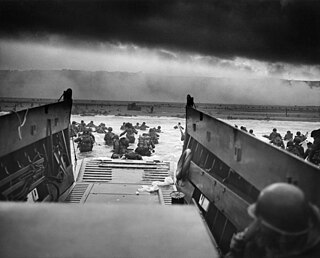
The Normandy landings were the landing operations and associated airborne operations on 6 June 1944 of the Allied invasion of Normandy in Operation Overlord during the Second World War. Codenamed Operation Neptune and often referred to as D-Day, it is the largest seaborne invasion in history. The operation began the liberation of France, and the rest of Western Europe, and laid the foundations of the Allied victory on the Western Front.
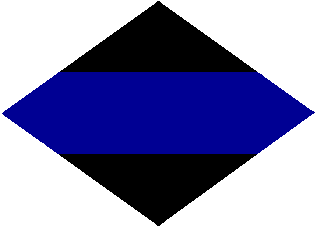
The 2nd Canadian Armoured Brigade was an armoured brigade of the Canadian Army that saw active service during World War II. The brigade was composed of the 6th, 10th and 27th Canadian Armoured regiments and saw service in northwest Europe, landing in Normandy on D-Day and remaining in combat up to Victory in Europe Day.

The Polish 1st Armoured Division was an armoured division of the Polish Armed Forces in the West during World War II. Created in February 1942 at Duns in Scotland, it was commanded by Major General Stanisław Maczek and at its peak numbered approximately 18,000 soldiers.The division served in the final phases of the Battle of Normandy in August 1944 during Operation Totalize and the Battle of Chambois and then continued to fight throughout the campaign in Northern Europe, mainly as part of the First Canadian Army.

The first USS Yarnall (DD–143) was a Wickes-class destroyer in the United States Navy during World War I later transferred to the Royal Navy as HMS Lincoln, to the Royal Norwegian Navy as HNoMS Lincoln, and subsequently to the Soviet Navy as Druzhny.

The 79th Armoured Division was a specialist armoured division of the British Army created during the Second World War. The division was created as part of the preparations for the Normandy invasion on 6 June 1944, D-Day.
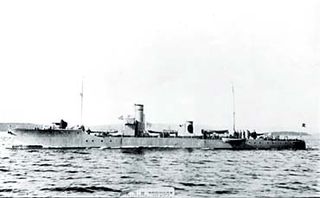
HNoMS Trygg was a torpedo boat of the Royal Norwegian Navy. Her hull was built in Moss and she was finished in Horten, with build number 109. Trygg had two sister ships: HNoMS Snøgg and HNoMS Stegg. Together the three vessels formed the Trygg class of torpedo boats.

The 11th Armoured Division was an armoured division of the British Army which was created in March 1941 during the Second World War. The division was formed in response to the unanticipated success of the German panzer divisions. The 11th Armoured was responsible for several major victories in the Battle of Normandy from in the summer of 1944, shortly after the Normandy landings, and it participated in the Allied advance from Paris to the Rhine, the Rhine crossing in March 1945. It was disbanded in January 1946 and reformed towards the end of 1950. In 1956, it was converted into the 4th Infantry Division.
Equipment losses in World War II or Matériel losses in World War II refers to military equipment destroyed during World War II, the deadliest and most costly war in human history.

Operation Overlord was the codename for the Battle of Normandy, the Allied operation that launched the successful liberation of German-occupied Western Europe during World War II. The operation was launched on 6 June 1944 (D-Day) with the Normandy landings. A 1,200-plane airborne assault preceded an amphibious assault involving more than 5,000 vessels. Nearly 160,000 troops crossed the English Channel on 6 June, and more than two million Allied troops were in France by the end of August.

The Norwegian armed forces in exile were remnants of the armed forces of Norway that continued to fight the Axis powers from Allied countries, such as Britain and Canada, after they had escaped the German conquest of Norway during World War II.

HNoMS Æger was a Sleipner-class destroyer launched at Karljohansvern naval shipyard in Horten in 1936. The Sleipner class was part of a Norwegian rearmament scheme started as war became ever more likely in the 1930s. When the Germans invaded Norway on 9 April 1940, Æger intercepted and sank the clandestine German supply ship Roda. She was shortly afterwards attacked and sunk by German bombers, claiming two of the attacking aircraft with her anti-aircraft armament before being taken out of action by a heavy bomb. This makes her the first naval ship sunk by aeroplane in hostility.

HNoMS Gyller was a Sleipner-class destroyer commissioned into the Royal Norwegian Navy in 1938. Along with the other Sleipner-class vessels in commission at that time, she took part in protecting Norwegian neutrality during the Second World War. After initially serving in the far north during the Finno-Soviet Winter War, she was redeployed to Southern Norway, escorting ships through Norwegian territorial waters. When the Germans invaded Norway on 9 April 1940, she was docked at Kristiansand. After taking part in the defence of the port city, she was captured intact by the invading Germans. Renamed Löwe, she sailed with Nazi Germany's Kriegsmarine for the duration of the war.

HNoMS Nordkapp was the lead ship of the Nordkapp class of fishery protection vessels. She was launched 18 August 1937 at Horten naval shipyard, with yard number 123. She had one sister ship, HNoMS Senja. Nordkapp was named after the North Cape in Finnmark. As was typical of her class, Nordkapp was very unstable in rough seas and was viewed from the beginning as a second-rate vessel. Nordkapp sailed throughout the Second World War and saw service in several theatres.
The 1st Assault Brigade Royal Engineers was a specialised armoured formation of the British Army active in the Second World War. It was formed in mid-1943 and its structure was three assault regiments of the Royal Engineers. It was assigned to the 79th Armoured Division in preparation for the Normandy invasion of 6 June 1944. The unit comprised armoured vehicles modified for specialist roles, intended to assist with the landing phase of the operation.
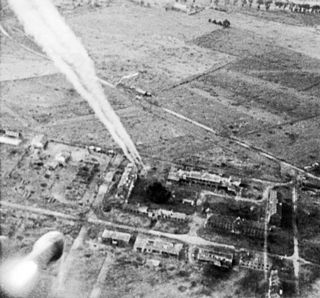
Operation Windsor(4–5 July 1944), was a Canadian attack of the Battle of Normandy during the Second World War. The attack was undertaken by the 3rd Canadian Infantry Division to take Carpiquet and the adjacent airfield from troops of the 12th SS-Panzer Division Hitler Jugend of Panzergruppe West. The attack was originally intended to take place during the later stages of Operation Epsom, to protect the eastern flank of the main assault but was postponed for a week.
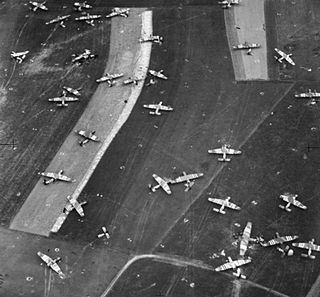
Operation Mallard was the codename for an airborne forces operation, which was conducted by the British Army on 6 June 1944, as part of the Normandy landings during the Second World War.
Escort Group B6 was a British convoy escort group of the Royal Navy which saw action during the Second World War, principally in the Battle of the Atlantic.

This is the Juno Beach order of battle on D-Day.




















